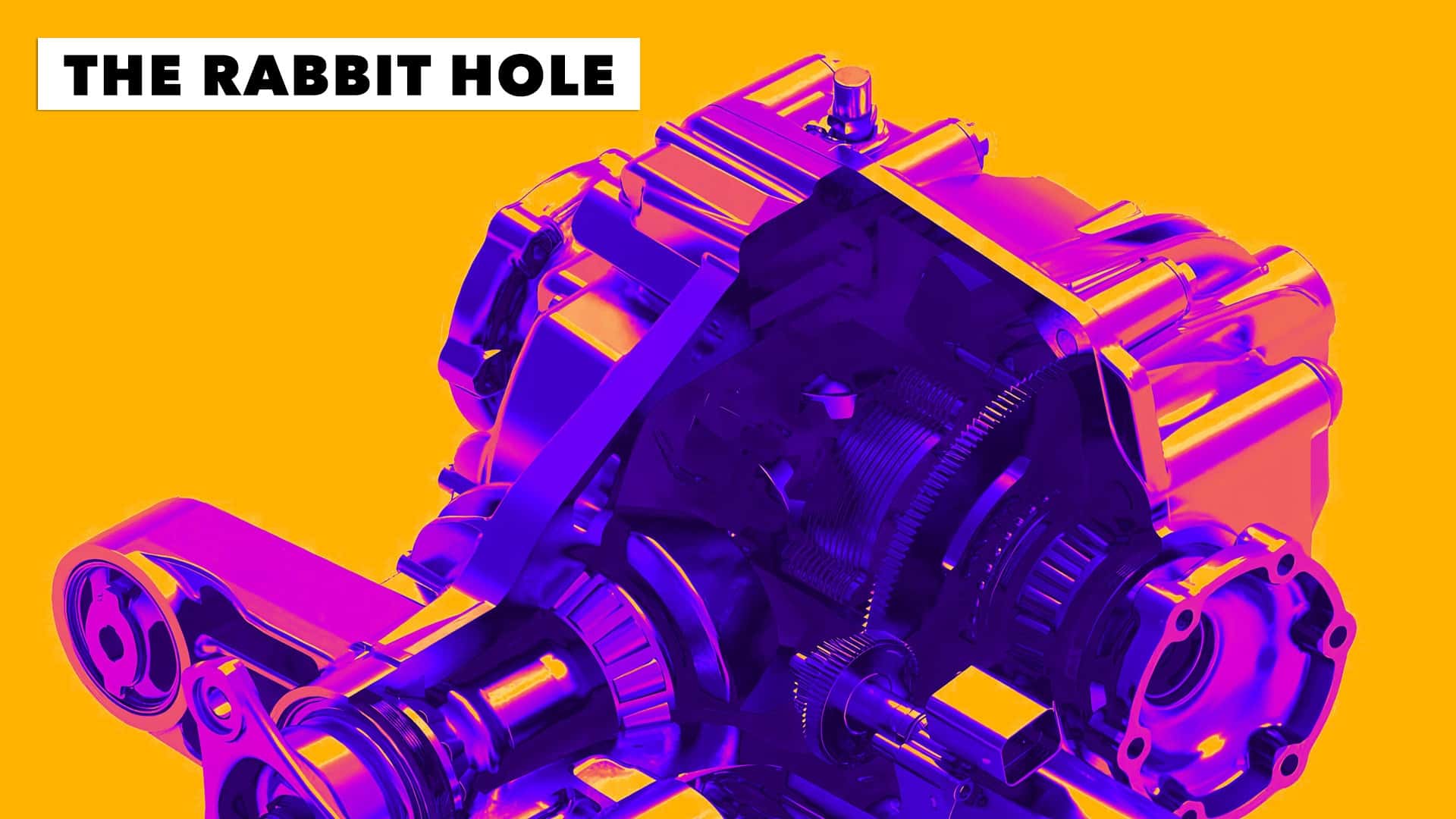
A few years ago, I found myself in a familiar position as a car enthusiast: Shopping for an NA Miata. My criteria was simple and typical—I wanted one of the later 1.8-liter cars (for their extra torque), a rust-free chassis (not a given in the Northeast), a manual (duh), and a limited-slip differential. The conventional enthusiast wisdom is that you always want an LSD, but back then, I couldn’t quite tell you why.
I knew an LSD helped you do burnouts and big drifts, and helped you put power down to the ground. But that was about it. Flash forward five years, and I now know that an LSD does so much more. It’s one of the most important components when it comes to overall vehicle handling.
Welcome to The Rabbit Hole, a bi-weekly column where Senior Editor Chris Perkins explores his latest obsession with automotive technology. He speaks to the best in the business to understand how cars work and what the future of the automobile looks like.
First, a quick review of differentials. An "open" differential, the most common type in cars, allows connected wheels to spin at different speeds. This is useful because, when cornering, the inside and outside wheels trace different arcs, and thus rotate at different speeds. Without a differential, cornering is extremely difficult. Which is why the differential actually predates the car itself.
A locked differential is useful, though. Locking the rear wheels together, forcing them to rotate at the same speed, helps generate traction. This is good in a straight line, and in low-grip conditions, especially where one wheel is on a very slippery surface and the other isn’t. That’s why you’ll see locked differentials in dragsters, and locking differentials—as in a differential that can be fully open or fully locked—in off-roaders.
An open differential is fine in the vast majority of normal driving scenarios. Your average commuter’s Toyota Camry probably doesn’t need an LSD, but in some cars, especially in performance applications, it’s really helpful to have a diff that bridges the gap between the two extremes.

An LSD allows the wheels of a driven axle to rotate at different speeds, but also allows for some amount of locking factor between the two. LSDs play in the area between 0 and 100 percent coupling, which is where the real magic happens.
The first production LSDs used multi-plate clutch packs to lock together the output shafts on either side in certain operating conditions. Here, the locking factor is determined by the number and orientation of clutch plates, and the clutches are engaged by some sort of pre-load system.
A viscous LSD uses a fluid that engages the clutch discs as it heats up under load. A torque-sensing (Torsen) LSD uses gears that are gradually meshed together as input torque increases. Finally, an electronic LSD uses an electric motor to put pressure on the clutch packs.
I could go deep here into the mechanics of all these LSD types, and the other, rarer types, but I’ll save that for another day. This would be a very long story otherwise.
Today, I’m more interested in talking about vehicle handling than the specifics of how an LSD works. (There are plenty of videos out there detailing this, or if you like reading, I highly recommend Race Car Vehicle Dynamics for an explanation of the topic and a whole lot of other neat stuff.)
For the purposes of this story, though, know that there are three types of LSDs in terms of when they lock up: 1-way LSDs only work under acceleration; 1.5-way LSDs work under acceleration and partially under braking; 2-way LSDs work on both acceleration and deceleration.
(It’s worth noting that the terms power and acceleration are used interchangeably to describe what an LSD does when you’re on throttle, as are the terms deceleration, coast, and overrun to describe what an LSD is doing any time you’re off throttle.)

What helped me learn about LSDs of all types was diving into GM’s e-LSDs, which are constantly adjusting their locking factor to achieve different results. I spoke with GM’s Ron Morris, who does the e-LSD tuning for Corvette and Cadillac, and not coincidentally is a handy driver on track.
"If you were to plot e-LSD coupling on a chart," Morris explains, "it starts at really high coupling down the straight, then it slowly bleeds down to the apex—it almost follows vehicle speed to be honest—then it increases back up out of the corner."
Let’s parse this out a bit. LSD locking on the straight helps keep the car stable. Remember that it’s basically impossible to turn in a car with a fully locked differential. Forcing the driven wheels to rotate at the same speed creates terminal understeer. But here, where straight-line stability is key, having a bit of diff locking is a good thing. Morris uses the term yaw damping and tells us that, typically, in a Cadillac Blackwing, they’ll run about 50 percent diff coupling.
That yaw damping is useful on your initial braking application too, as you don’t want the rear of the car to start wandering out from under you at triple-digit speeds. But as you bleed off speed, things get a lot more interesting.
"As you roll off the brake pedal and steer into the corner, honestly, that's where 90 percent of the magic happens with the GM e-LSD," Morris says.

GM’s modern performance cars have a system called Performance Traction Management (PTM) that integrates various systems—powertrain, MagneRide dampers, ABS, and of course, e-LSD—to help you go faster around a track. Even a performance car in its normal driving mode has to be designed for safety above all.
When you use one of PTM’s five modes, you’re essentially making a tacit agreement that you’re on a track, you know what you’re doing, and you want the car to help you find speed. The e-LSD plays a huge part.
Racing drivers talk about rotation a lot, and essentially, what they’re describing is the car’s (and their) ability to get the car to bend into a corner. This is technically oversteer, where the rear tires are on a wider path than the fronts, though not the tire-smoking countersteering kind.
Trail braking, bleeding off the brake pedal as you steer down toward the apex, helps pivot the car into the corner. An LSD that works under deceleration is a further aid. An e-LSD is even better.
"As we open that clutch just the right amount as you’re diving into a corner, we can really dial so you can huck it into the corner with confidence," Morris says. "It doesn’t step out on you, and it’s also not pushing and understeering really badly. It's a driver-intended path, just that right amount of magical rotation. That’s where a significant amount of engineering time is spent."
By the time you get to the apex, you want the diff locking to be at or about zero, since that’s when you want the most possible rotation. As soon as you start getting back to power and unwinding the steering, though, you want the diff to ramp up.

Going back to throttle in a front- or all-wheel drive car will likely create understeer, the car pushing to its track-out point. In a rear-wheel drive car, however, it’s very easy to overwhelm the rear tires on throttle and generate time-sapping oversteer. A bit of added differential locking in all instances helps bring the car back straight and adds stability. And then, the cycle can repeat itself.
Electronic or not, it becomes obvious that the limited-slip differential is a powerful tool.
"I think a lot of people think of it as a tractive effort enabler. It obviously does help with [corner exit], but it’s a dramatically powerful actuator for vehicle balance," Morris. "Corner entry, steady-state cornering, those types of things."
The e-LSD unlocks even more interesting possibilities since it can interact with other vehicle systems. That’s the brilliance of GM’s PTM system—the engineers have a lot of different levers they can pull to achieve a desired handling characteristic based on what the driver and the tire want. It means that Morris can’t work in a silo. He’s got to be in the simulator and at the track with other engineers to figure out which levers to pull when, and by how much.
Having an e-LSD also affects the hardware selection, too.

"Maybe we’re going to pick a more aggressive anti-roll bar because now we can use the e-LSD to—I don’t even want to say mitigate the trade-off, but completely get rid of it," Morris says. "It’s no longer a trade-off to have a more aggressive vehicle hardware selection because now we can use the diff to stabilize the car where it needs to be, and let that hardware rotate the car where we want it."
It’s worth mentioning too that ABS can sort of simulate the effect of an LSD, by braking an individual wheel to help create a yaw moment. But, Morris points out this is inefficient since you’re wearing and heating up the brakes, and wasting engine power.
Eventually, I did buy an NA Miata. My father found one local to my hometown that was clean and cheap, and the seller claimed it had an LSD despite it being a low-option car that wouldn’t have come with one from the factory.
My dad attempted to verify this fact by laying down two tire marks on his garage floor, which seemed to prove it. But, I once did a one-tire burnout with it… which seemed to prove it had an open differential.
Frankly, it didn’t matter. Knowing what I know now, there’s no way I would have appreciated it.







